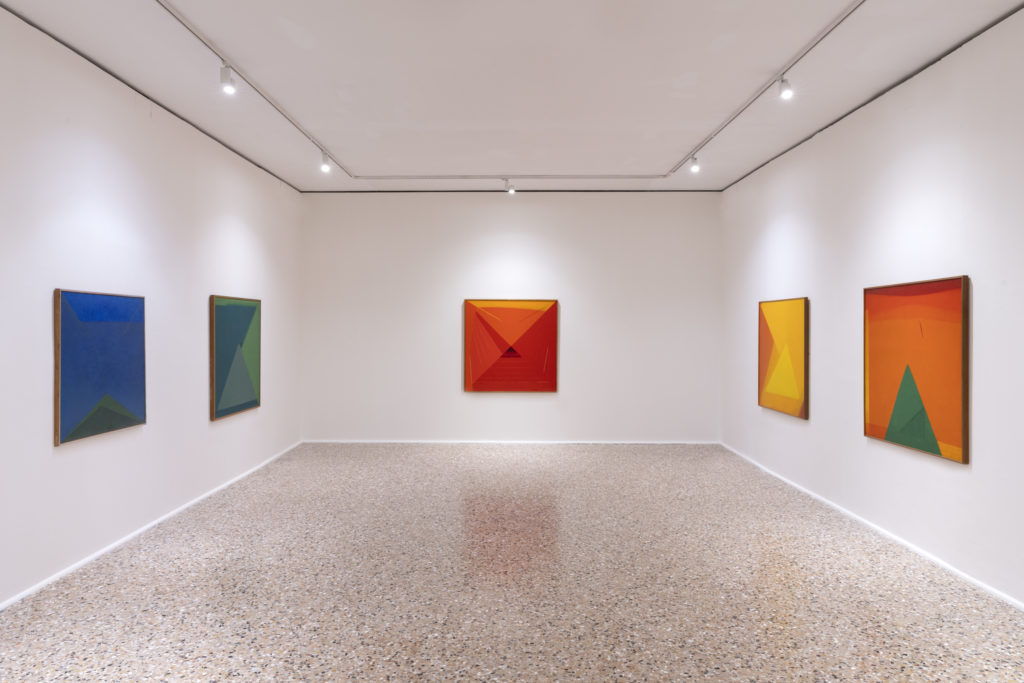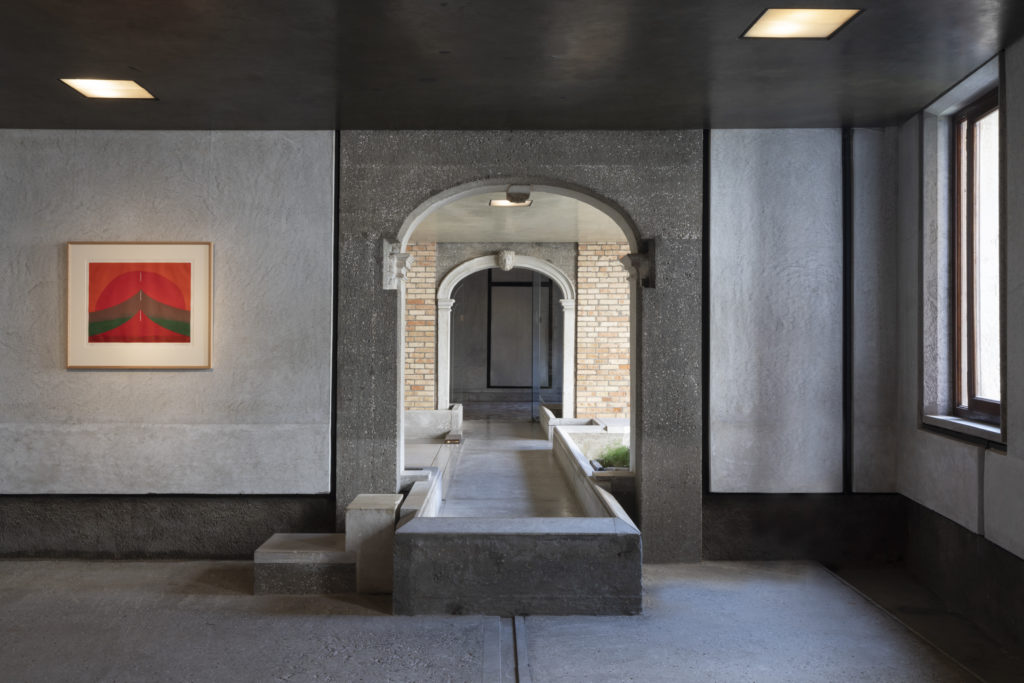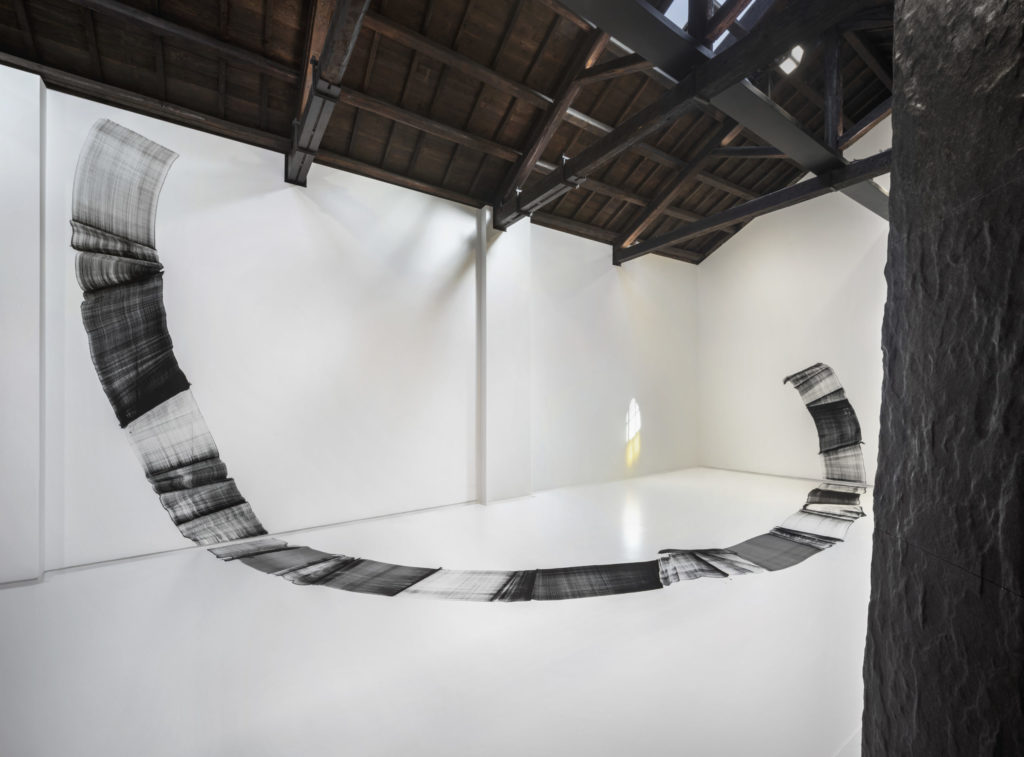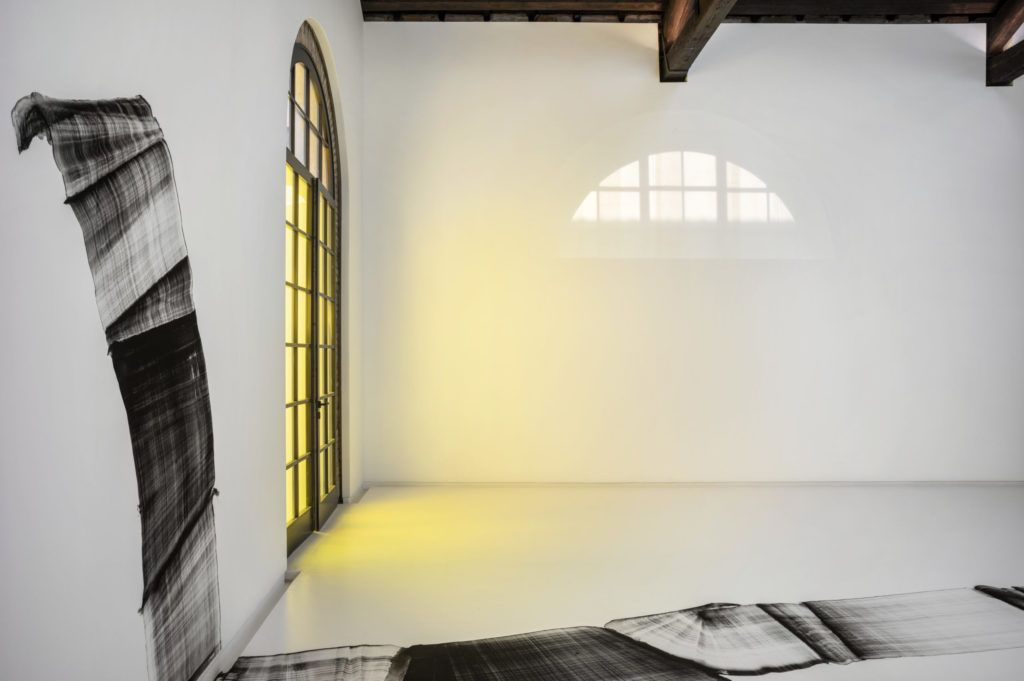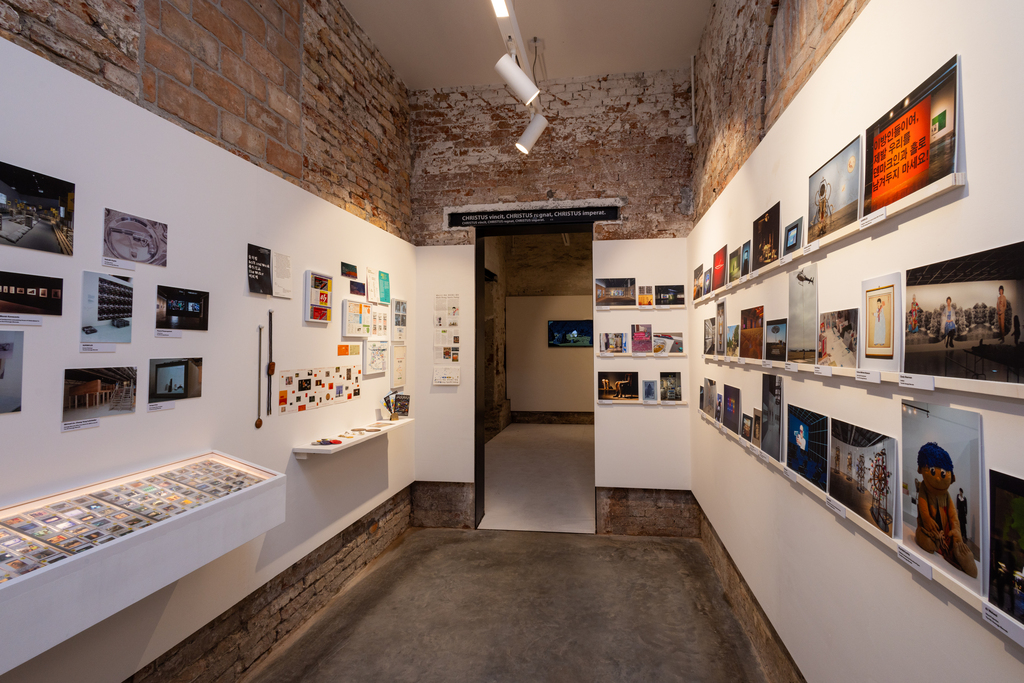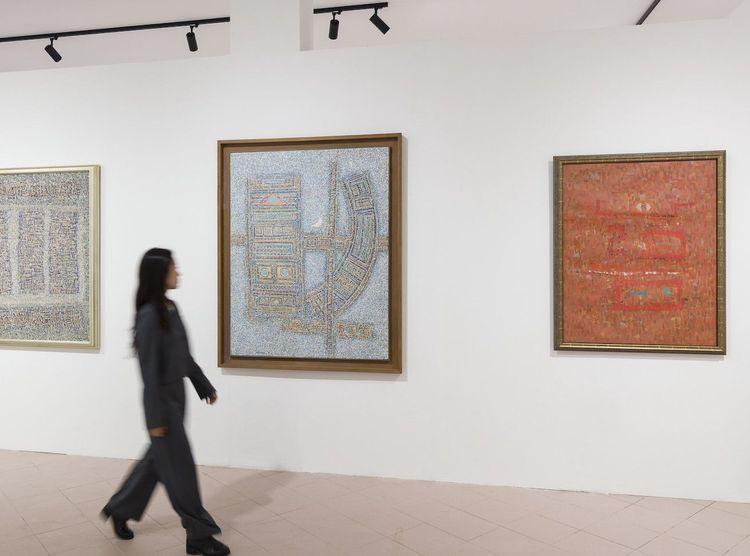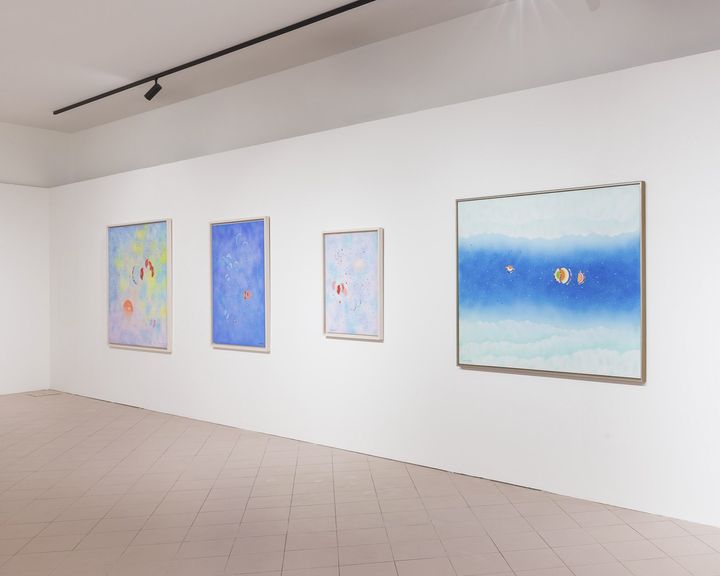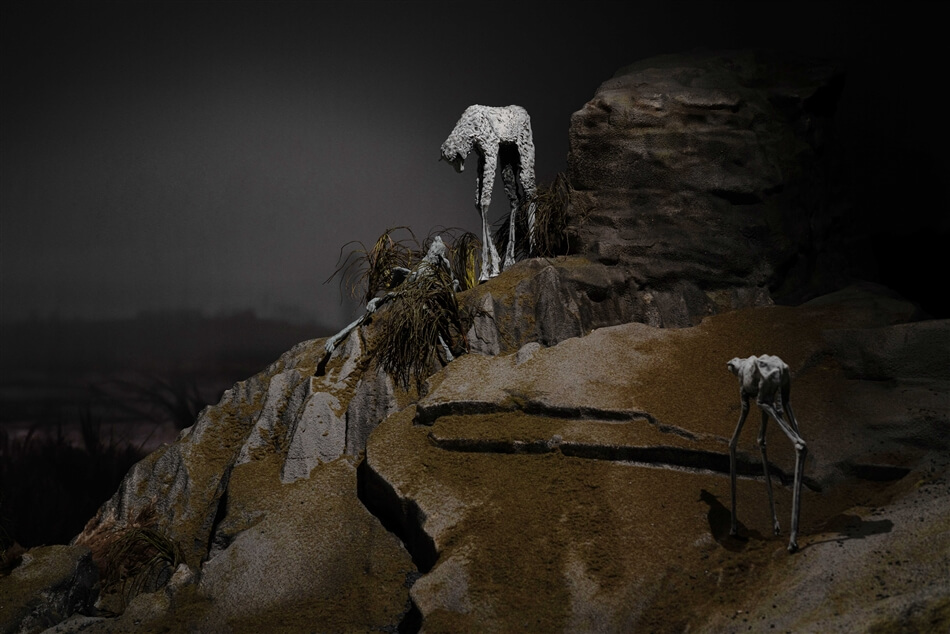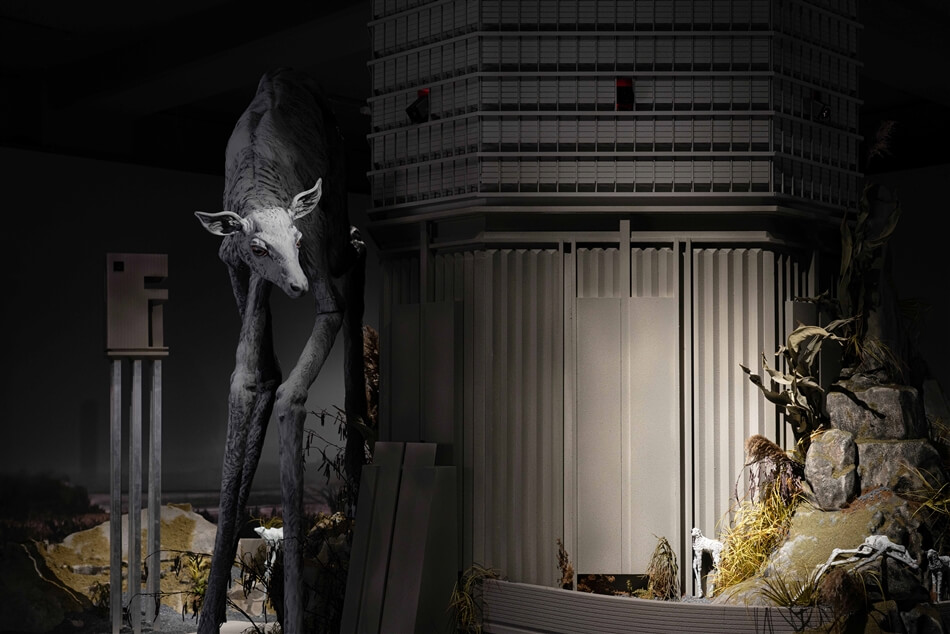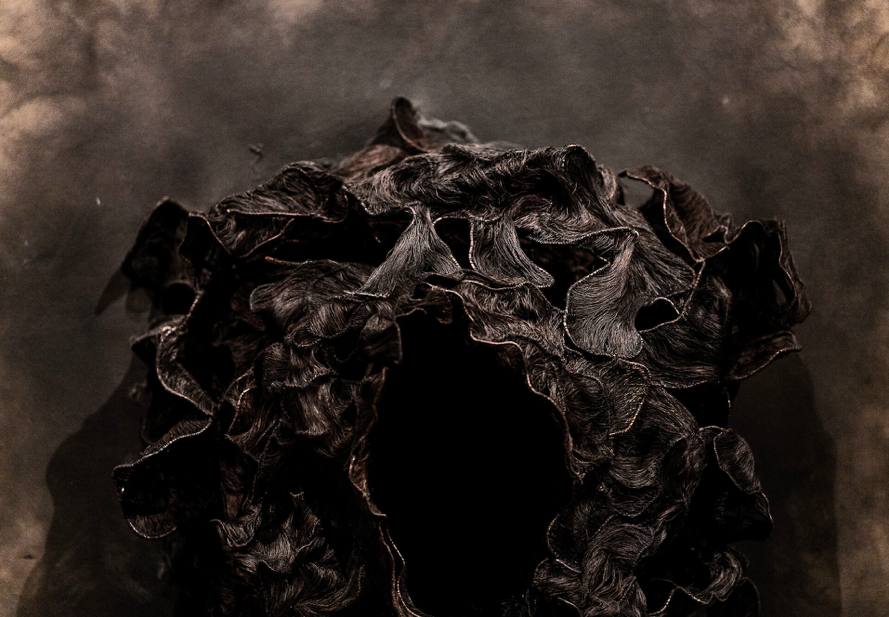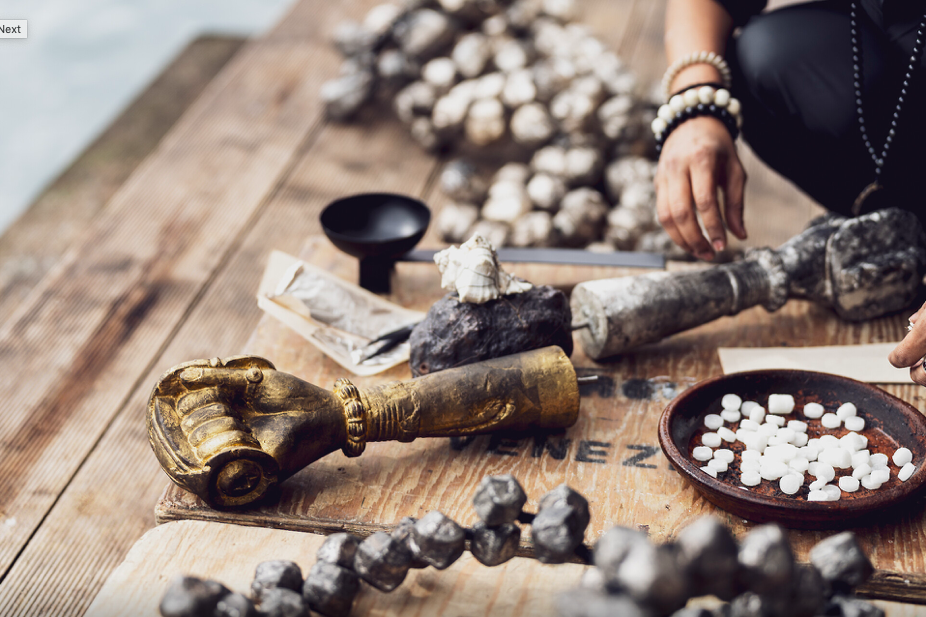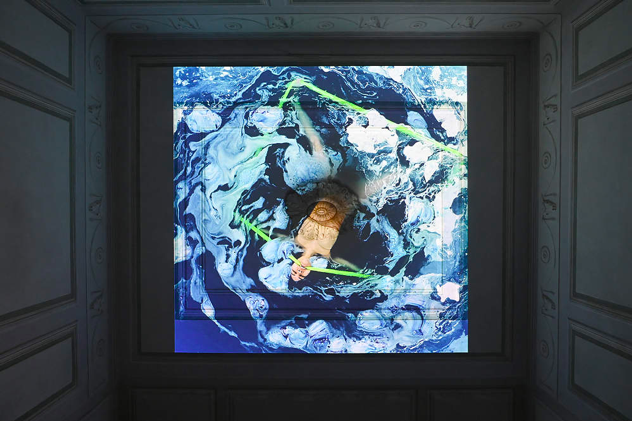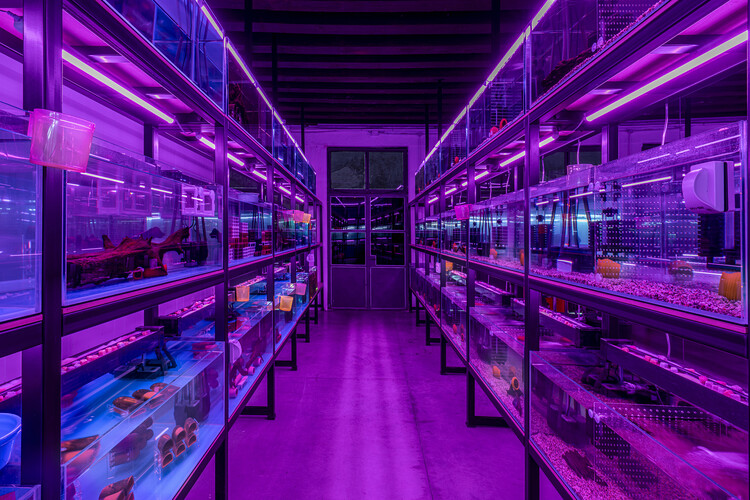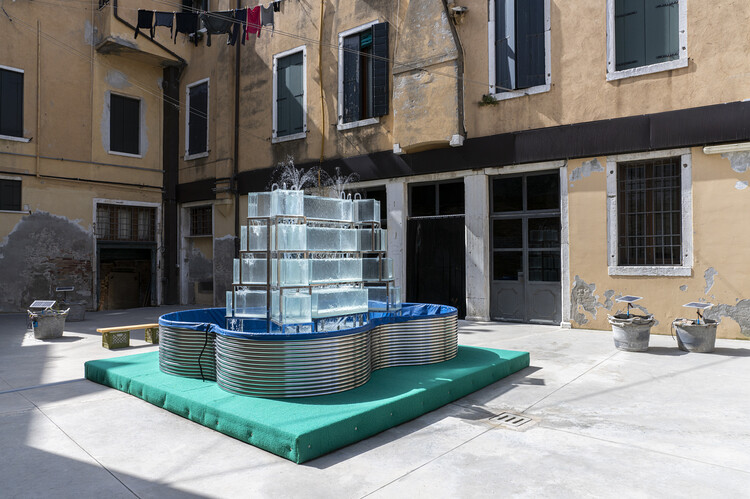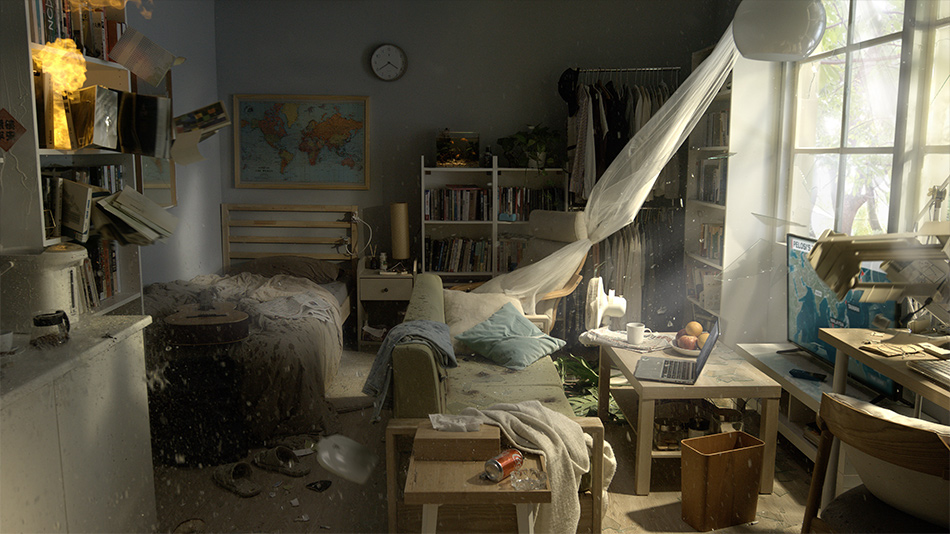Selection by Seoha Park
Les expositions collatérales / Collateral exhibitions
En marge des Pavillons nationaux et de l’Exposition principale de la Biennale de Venise, se tient une trentaine d’expositions collatérales, organisées par des institutions et entreprises nationales et internationales, disséminées dans divers lieux de la ville – on y remarque notamment, une forte présence des projets sud coréens. ACA project vous présente sa sélection de 10 événements collatéraux à ne pas manquer, visibles jusqu’au 26 novembre.
Alongside the national pavilions and the main exhibition at the Venice Biennale, there are some thirty collateral exhibitions, organised by national and international institutions and companies, scattered around the city – we can notice a strong presence of South Korean projects. ACA project presents its selection of 10 events worth visiting until November 26.
“A Journey to the Infinite: Yoo Youngkuk” by Yoo Youngkuk Art Foundation at Fondazione Querini Stampalia, Campo Santa Maria Formosa 5252
La Fondation d’art Yoo Youngkuk annonce une exposition spéciale de Yoo Youngkuk (1916-2002), pionnier de l’art abstrait coréen et figure clé de l’avant-garde coréenne, intitulée « A Journey to the Infinite ». Cette exposition met en lumière la période cruciale des années 1960 et 1970 dans le parcours de l’artiste, en soulignant la transition des formes organiques aux formes géométriques et à l’expérimentation. Des couleurs primaires audacieuses et des variations subtiles de tons chauds et froids montrent l’exploration infinie de l’abstraction pure par l’artiste. Tenue sur trois étages du Palazzo Querini Stampalia, l’exposition présente plus de 30 peintures à l’huile, 14 estampes, 8 dessins et environ 40 documents d’archives, offrant une introduction condensée et essentielle à la vie et à l’art de Yoo. « A Journey to the Infinite » n’est pas seulement la deuxième exposition de Yoo Youngkuk sur la scène artistique occidentale depuis sa première exposition solo à la Pace Gallery de New York l’année dernière, mais aussi sa première exposition solo en Europe.
Yoo Youngkuk Art Foundation is pleased to announce a special exhibition of Yoo Youngkuk (1916-2002), a pioneer of Korean abstract art and a key figure of Korean avant-garde, entitled « A journey to the infinite ». This exhibition sheds light on the pivotal period of the 1960 and 1970s in Yoo’s artistic journey, highlighting the transition from organic forms to geometric shapes and experimentation. Bold primary colors and subtle variations in warm and cool tones showcases the artist’s endless exploration of pure abstraction. Held across three floors of Palazzo Querini Stampalia, the exhibition features over 30 oil paintings, 14 prints, 8 drawings, and around 40 archival materials, providing a condensed and essential introduction to Yoo’s life and art. « A journey to the infinite » is not only You Youngkuk’s second exhibition in the western art scene since his solo show at the Pace gallery in New York last year but also his first solo exhibition in Europe.
“Lee Bae – La Maison de La Lune Brûlée” by Fondation d’Entreprise Wilmotte and Foundation Hansol of Culture, at Fondation d’Entreprise Wilmotte, Corte Nuova, Fondamenta dell’Abbazia, Cannaregio 3560
L’exposition « La Maison de La Lune Brûlée » explore la profonde connexion de l’artiste Lee Bae (née en 1956) avec le ‘Daljip Teugi’, un rituel centenaire synchronisé avec la cosmologie cyclique, mêlant folklore et art contemporain. Elle examine le lien intrinsèque de l’humanité avec la nature, prônant un retour au renouveau et à la circularité. Cette exposition en deux parties, se déroulant avant et pendant la Biennale, engage les communautés locales, nationales et mondiales. Des messages du monde entier collectés avant la Biennale et transcrits sur du papier hanji, papier traditionnel coréen, incarnant des vœux pour la nouvelle année, sont devenus une partie intégrante du rituel de la Maison de la Lune Brûlée, tenu le 24 février à Cheong-do lors de la première pleine lune de l’année. Pendant la Biennale, l’exposition hébergée à la Fondation Wilmotte permet aux visiteurs de s’immerger dans l’essence du ‘Daljip Teugi’ et de son matériau principal, le charbon de bois, le médium signature de Lee Bae. À travers des vidéos, de l’audio, des sculptures, des installations spécifiques au site et des structures contemplatives, l’espace de la fondation devient un moment expérientiel où les visiteurs peuvent « ressentir » non seulement la combustion de la maison de la lune, mais aussi plonger dans la philosophie coréenne et son esthétique dérivée.
The exhibition « La Maison de La Lune Brûlée » explores Lee Bae’s deep connection with ‘Daljip Teugi’, a century-old ritual synchronized with cyclical cosmology, intertwining folklore with contemporary art. It delves into humanity’s intrinsic connection with nature, advocating for a return to renewal and circularity. This two-part exhibition engages folk, local, and global communities, unfolding before and during the Biennale. The worldwide messages collected before the Biennale are transcribed onto hanji paper, a traditional Korean medium, embody wishes for the new year and became integral to the Moonhouse Burning ritual held on February 24th in Cheong-do during the inaugural full moon. Throughout the Biennale, the exhibition hosted at the Wilmotte Foundation allows visitors to immerse themselves in the essence of ‘Daljip Teugi’ and its primary material, charcoal, Lee Bae’s signature medium. Through video, audio, sculpture, site-specific installations, and contemplative structures, the foundation’s space becomes an experiential moment, where visitors can « sense » not only the moonhouse burning but also delve into Korean philosophy and its derivative aesthetic.
“Madang: Where We Become Us” by Gwangju Biennale Foundation, at Il Giardino Bianco Art Space, Castello 1814
“Madang: Where We Become Us”, exposition commémorative spéciale marquant le 30e anniversaire de la Fondation de la Biennale de Gwangju, réfléchit sur l’histoire de la biennale et envisage son avenir. La Biennale de Gwangju est devenue la principale biennale d’art contemporain en Asie en mêlant l’« esprit de Gwangju », qui incarne des valeurs telles que la révolution, la démocratie et la communauté, au domaine de l’art. Cette exposition, composée de documents d’archives accumulés au fil des ans, d’œuvres de la collection de la Fondation de la Biennale de Gwangju et d’œuvres supplémentaires élargissant sa signification, ne cherche pas seulement à retracer l’histoire de la biennale ; elle a pour objectif global de proposer une perspective qui contemple l’esprit de Gwangju à travers les lacunes et les scènes existant au sein des matériaux et des œuvres d’art, rétablissant ainsi la valeur contemporaine de la Biennale de Gwangju.
Fonctionnant comme une porte d’entrée vers l’art contemporain international, la Biennale de Gwangju a dépassé le simple fait d’importer de l’art occidental pour embrasser les flux synchroniques et la diversité culturelle de l’art mondial qui s’étend à l’Amérique du Sud, à l’Afrique et au Moyen-Orient. Les thèmes explorés dans les expositions de la Biennale de Gwangju, tels que la crise climatique, la race, le genre et la démocratie, témoignent de son effort pour transcender les frontières géographiques et contempler l’époque d’un point de vue planétaire. Simultanément, le discours de la communauté, une partie intégrante de la Biennale de Gwangju depuis ses débuts, a recherché la diversité sous diverses formes et échelles, allant de la ville de Gwangju à la Corée, l’Asie et la communauté mondiale. Sur fond de guerres en cours, de discrimination et de haine envers les minorités à travers le monde, la Fondation de la Biennale de Gwangju réaffirme une fois de plus le pouvoir de l’art comme un madang (un jardin intérieur), symbole de diversité et d’inclusion.
“Madang: Where We Become Us”, a special commemorative archival exhibition marking the 30th anniversary of the Gwangju Biennale Foundation, reflects on the biennale’s history and envisions its future. The Gwangju Biennale has evolved into Asia’s leading contemporary art biennale by intertwining the “spirit of Gwangju,” which embodies values such as revolution, democracy, and community, with the realm of art. This exhibition, comprised of archival materials accumulated over the years, works from the Gwangju Biennale Foundation collection, and additional works expanding its significance, does not merely seek to chronicle the biennale’s history; it has the overarching goal of proposing a perspective that contemplates the spirit of Gwangju through the gaps and scenes existing within materials and artworks, reestablishing the contemporary value of the Gwangju Biennale.
Functioning as a gateway to contemporary international art, the Gwangju Biennale has moved beyond merely importing Western art to embrace the synchronic flows and cultural diversity of global art that extends to South America, Africa, and the Middle East. The themes explored in the Gwangju Biennale’s exhibitions, such as the climate crisis, race, gender, and democracy, are a testament to its endeavor to transcend geographical boundaries and contemplate the era from a planetary perspective. Simultaneously, the discourse of community, an integral part of the Gwangju Biennale from its inception, has sought multifariousness in various scales and forms, ranging from Gwangju city to Korea, Asia, and the global community. Against the backdrop of ongoing wars, discrimination, and hatred towards minorities across the globe, the Gwangju Biennale Foundation once again affirms the power of art as a ‘madang’ (interior garden), symbolizing diversity and inclusion.
“Seundja Rhee: Towards the Antipodes” by KoRICA (Korean Research Institute of Contemporary Art), at ArteNova, Castello 5063
Le Korean Research Institute of Contemporary Art (KoRICA), avec le soutien de la Fondation Seundja Rhee et de la Galerie Hyundai, organise une exposition personnelle de l’artiste Seundja Rhee intitulée “Towards the Antipodes ». Seundja Rhee (1918-2009) est reconnue comme la seule pionnière féminine de l’art abstrait coréen, aux côtés de Kim Whanki et Yoo Youngkuk. Tout au long de sa carrière de 60 ans, Rhee a enraciné son travail dans la vision philosophique orientale du « Yin-Yang et les Cinq Éléments ». En 1951, elle a déménagé en France, sa seconde patrie, où elle a mélangé son esprit unique avec les styles de peinture occidentaux qu’elle a appris, explorant l’art abstrait qui fusionnait les contextes artistiques et culturels orientaux et occidentaux.
« Seundja Rhee : Towards the Antipodes » est sa première exposition personnelle à l’étranger depuis son décès en 2009, en dehors de la Corée et de sa seconde patrie, la France. L’exposition, qui présente plus de 20 œuvres représentatives, allant de ses pièces initiales de 1959 à ses œuvres tardives de 2008, vise à témoigner de l’esprit de chaque période et à explorer l’art et le parcours esthétique de Rhee, marqué par une expérimentation formelle continue. L’artiste, qui a passé plus de la moitié de sa vie en France tout en restant profondément connectée à sa patrie, la Corée, a créé un corpus de travaux indépendant et original qui se démarquait des courants principaux de l’histoire de l’art moderne et contemporain dans les deux pays. Sa vie en tant qu’« Autre » dans le monde de l’art résonne étroitement avec le thème de l’exposition principale de la Biennale de Venise de cette année, « Stranieri Ovunque – Foreigners Everywhere ».
The Korean Research Institute of Contemporary Art (KoRICA) with the support of the Seundja Rhee Foundation, and Gallery Hyundai are hosting a solo exhibition of Seundja Rhee entitled “Towards the Antipodes”. Seundja Rhee (1918-2009) is recognized as the only female pioneer of Korean abstract art, alongside Kim Whanki and Yoo Youngkuk. Throughout her 60-year career, Lee rooted her work in the Eastern philosophical worldview of ‘Yin-Yang and the Five Elements’. In 1951, she moved to France, her second home, where she blended her unique spirit with the Western painting styles she learned, exploring abstract art that merged Eastern and Western artistic and cultural backgrounds.
« Seundja Rhee ; Towards the Antipodes” is her first solo exhibition held abroad since her passing in 2009, outside of Korea and her second home, France. The exhibition features over 20 representative works from her early pieces in 1959 to her later works in 2008, aiming to capture the zeitgeist of each period and to explore Rhee’s artistry and aesthetic journey marked by continuous formal experimentation. The artist, who spent more than half of her life in France while remaining deeply connected to her homeland Korea, created an independent and original body of work that stood apart from the main currents of modern and contemporary art history in both countries. Her life as an ‘Other’ in the world of art resonates closely with the theme of this year’s Venice Biennale main exhibition, « Stranieri Ovunque – Foreigners Everywhere ».
“Above Zobeide, Exhibition from Macao, China” by Macao Museum of Art, at Instituto Santa Maria della Pietà, Calle della Pietà, Castello 3701
Organisée par le Musée d’Art de Macao, l’exposition curatée par Chang Chen « Above Zobeide, Exhibition from Macao, China » présente des installations artistiques à grande échelle et des impressions numériques de l’artiste macanais Wong Weng Cheong. Inspiré par la ville fictive de Zobeide dans le roman « Les Villes Invisibles » d’Italo Calvino, Wong s’appuie sur l’histoire de sa fondation – une entreprise collective d’un groupe d’hommes étrangers qui poursuivent chacun la même femme à travers leurs rêves. Les œuvres de Wong explorent l’impact historique du désir matérialiste dans le contexte de la colonisation et de la mondialisation. En présentant un paysage urbain-pastoral habité par des herbivores mutants aux jambes anormalement allongées, la juxtaposition frappante de la civilisation et de la mutation reflète une angoisse apocalyptique universelle, incitant à la réflexion sur la relation complexe entre l’humanité et son environnement. En entrant dans l’espace d’exposition, les visiteurs pénètrent dans un monde étranger où les frontières entre natif et intrus deviennent floues. L’artiste invite les observateurs à naviguer dans ce terrain étrangement (in)familier et à réfléchir sur leur propre déplacement physique et spirituel croissant.
Organised by the Macao Museum of Art, the exhibition curated by Chang Chen “Above Zobeide, Exhibition from Macao, China” showcases large-scale art installations and digital prints by Macao artist Wong Weng Cheong. Inspired by the fictional city of Zobeide in Italo Calvino’s novel Invisible Cities, Wong draws on the story of its founding – a collective endeavor of a group of foreign men who each pursue the same woman through their dreams. Wong’s artwork explores the historical impact of materialistic desire within the context of colonization and globalization. By presenting an urban-pastoral landscape inhabited by mutant herbivores with unnaturally elongated legs, the stark juxtaposition of civilization and mutation mirrors a universal apocalyptic anxiety, prompting contemplation of the intricate relationship between humanity and its environment. As visitors step into the exhibition space, they enter an alien world where boundaries between native and intruder become blurred. The artist invites observers to navigate this strangely (un)familiar terrain and reflect on their own escalating physical and spiritual displacement.
“Cosmic Garden” by Chanakya Foundation at Salone Verde – Art & Social Club, Calle Regina 2258
“Cosmic Garden » est née d’une collaboration dynamique et continue entre les célèbres artistes indiens Madhvi Parekh et Manu Parekh, en partenariat avec Karishma Swali, directrice artistique de la Chanakya School of Craft de Mumbai – une institution à but non lucratif dédiée à l’autonomisation des femmes par l’artisanat. Faisant ses débuts à Venise, cette présentation célèbre la riche diversité de l’héritage artisanal et des traditions artistiques indigènes de l’Inde. Cette collection soigneusement organisée adopte une approche multidisciplinaire, remettant en question les hiérarchies idéologiques profondément ancrées dans le monde de l’art. Elle présente des réinterprétations contemporaines de techniques traditionnelles, repoussant les frontières conventionnelles pour établir un nouveau langage artistique enraciné dans des histoires culturelles partagées. L’exposition met en avant une diversité d’œuvres, incluant peintures et sculptures, qui convergent vers un troisième médium interdisciplinaire : la broderie à la main, un artisanat raffiné depuis des millénaires.
L’art de Manu Parekh intègre le tissu culturel indien avec des influences du modernisme occidental et de l’expressionnisme abstrait. Ses compositions vibrantes, caractérisées par des lignes fragmentées, des rayures, des croix et des motifs floraux, incarnent l’équilibre cosmique des énergies masculines et féminines. Les œuvres de Madhvi Parekh quant à elles, représentent des déesses féminines redoutables entourées d’êtres célestes et d’imaginaire symbolique, s’inspirant de la mythologie indienne pour souligner le lien entre l’humanité et le divin. Karishma Swali, en collaboration avec 320 artisans qualifiés de Chanakya, a conceptualisé et réalisé des réinterprétations textiles à travers un travail minutieux de broderie et de techniques artisanales, utilisant des matériaux naturels tels que le lin brut, le jute, la soie et le coton. Le résultat est une entreprise conceptuelle profonde : un dialogue créatif qui redéfinit les rôles de l’artiste et de l’artisan, brouillant les frontières entre l’art et l’artisanat.
« Cosmic Garden, » is born from a dynamic ongoing collaboration between renowned Indian artists Madhvi Parekh and Manu Parekh, in partnership with Karishma Swali, Artistic Director of Mumbai’s Chanakya School of Craft—a nonprofit institution dedicated to empowering women through craft. Making its debut in Venice, this presentation celebrates India’s rich diversity of artisanal legacies and indigenous art traditions. This meticulously curated collection takes a multidisciplinary approach, challenging entrenched ideological hierarchies in the art world. It showcases contemporary reinterpretations of traditional techniques, breaking conventional boundaries to establish a new artistic vernacular rooted in shared cultural histories. The exhibition features a diverse array of works, including paintings and sculptures, which converge into a third interdisciplinary medium—hand-embroidery—a craft refined over millennia.
Manu Parekh’s art integrates India’s cultural fabric with influences from Western modernism and abstract expressionism. His vibrant compositions, characterized by fragmented lines, stripes, crosses, and floral motifs, embody the cosmic balance of masculine and feminine energies. In contrast, Madhvi Parekh’s works portray formidable female deities surrounded by celestial beings and symbolic imagery, drawing from Indian mythology to underscore the connection between humanity and the divine.Karishma Swali, collaborating with 320 skilled artisans from Chanakya, conceptualized and executed textile reinterpretations through meticulous needlework and handcrafting techniques, using natural materials such as raw linen, jute, silk, and cotton. The result is a profound conceptual endeavor: a creative dialogue that redefines the roles of artist and artisan, blurring the lines between art and craft.
“Per non perdere il filo. Karine N’guyen Van Tham – Parul Thacker” by Fondazione dell’Albero d’Oro, at Palazzo Vendramin Grimani, San Polo 2033
La Fondazione dell’Albero d’Oro présente l’exposition “Per non perdere il filo. Karine N’guyen Van Tham – Parul Thacker” sous le commissariat de Daniela Ferretti. L’exposition accueille l’artiste franco-vietnamienne Karine N’guyen Van Tham et l’Indienne Parul Thacker. En résidence à Venise en février et mars, les artistes ont collaboré à l’installation de l’exposition en créant des œuvres spécifiques aux espaces du Palazzo. Karine N’guyen Van Tham et Parul Thacker, malgré leurs différences d’origine, de formation et de sensibilité, ont construit leur dialogue autour du thème du fil, utilisé comme moyen d’expression et métaphore évoquant l’écriture, le tissage, la couture et la broderie. Les œuvres délicates et poétiques de Karine N’guyen Van Tham, réalisées sur un métier à tisser de tradition orientale avec des éléments naturels, évoquent des voyageurs et conteurs d’époques immémoriales. Pendant l’exposition, elle crée une œuvre textile évolutive et une œuvre collective où les visiteurs sont invités à nouer des fils colorés. Les œuvres de Parul Thacker, inspirées par les sculptures de temples indiens, la cosmologie tantrique et la physique quantique, incluent une composition inspirée par une tapisserie du XVIIe siècle et une installation de 22 grandes toiles en organza brodées, accompagnées d’une bande sonore mêlant les sons du Rudra veena, du Grand Canal et des eaux de l’Arctique.
The Fondazione dell’Albero d’Oro presents the exhibition « Per non perdere il filo. Karine N’guyen Van Tham – Parul Thacker » curated by Daniela Ferretti. The exhibition features the French-Vietnamese artist Karine N’guyen Van Tham and the Indian artist Parul Thacker. During their residency in Venice in February and March, the artists collaborated on the installation of the exhibition by creating site-specific works for the spaces of the Palazzo. Despite their differences in origin, background, and sensitivity, Karine N’guyen Van Tham and Parul Thacker have built their dialogue around the theme of the thread, used as a means of expression and a metaphor evoking writing, weaving, sewing, and embroidery. Karine N’guyen Van Tham’s delicate and poetic works, created on a traditional oriental loom with natural elements, evoke travelers and storytellers from ancient times. During the exhibition, she creates an evolving textile work and a collective piece where visitors are invited to tie colorful threads. Parul Thacker’s works, inspired by the sculptures of Indian temples, tantric cosmology, and quantum physics, include a composition inspired by a 17th-century tapestry and an installation of 22 large hand-embroidered organza canvases, accompanied by a soundtrack that blends the sounds of the Rudra veena, the Grand Canal, and the Arctic waters.
“The Spirits of Maritime Crossing” by Bangkok Art Biennale Foundation at Palazzo Smith Mangilli Valmarana, Cannaregio 4392
La Fondation Bangkok Art Biennale (BAB) présente « The Spirits of Maritime Crossing », une exposition collective curatée par le Prof. Dr. Apinan Poshyananda. Présentant divers médiums tels que la peinture, la sculpture, les installations mixtes et vidéo, l’exposition met en avant les œuvres de quinze artistes originaires du Cambodge, d’Indonésie, du Laos, du Myanmar, de Malaisie, des Philippines, de Singapour, du Vietnam et de Thaïlande. Le thème explore le déplacement, la diaspora et le colonialisme à travers le prisme de l’océan, contrastant les cultures et histoires d’Asie du Sud-Est avec les récits occidentaux à Venise.
Installée dans un palais vénitien historique, l’exposition réfléchit sur les impacts du colonialisme et de la guerre, la spiritualité et l’importance de la nature en Asie du Sud-Est. Elle s’appuie sur les voix et récits locaux, soulignant la connexion culturelle et géographique de la région avec l’océan. « The Spirits of Maritime Crossing » présente un nouveau film du Prof. Dr. Apinan Poshyananda avec Marina Abramović et Pichet Klunchun, explorant la spiritualité et les relations Est-Ouest. L’exposition inclut également les œuvres de Natee Utarit, qui mêlent philosophie bouddhiste et histoire de l’art occidentale, les sculptures métalliques de Bounpaul Phothyzan faites de bombes recyclées, et une installation vidéo à deux canaux de Chitti Kasemkitvatana et Nakrob Moonmanas. D’autres œuvres notables incluent l’installation de Jompet Kuswidananto sur la colonisation et le travail missionnaire en Indonésie, les œuvres multimédias d’Alwin Reamillo sur le colonialisme et l’iconographie chrétienne aux Philippines, la vidéo de Khvay Samnang sur la déforestation au Cambodge, le film de Yee I-Lann sur la revitalisation des connaissances ancestrales en Malaisie, les textiles de Jakkai Siributr sur le nettoyage ethnique, les performances de Moe Satt sur la violence sectaire au Myanmar, la vidéo de Priyageetha Dia sur la migration ancestrale, la performance de Kawita Vatanajyankur sur le travail féminin et l’eau, et l’installation de Truong Cong Tung sur les mythologies indigènes.
The Bangkok Art Biennale (BAB) Foundation presents « The Spirits of Maritime Crossing, » a group exhibition curated by Prof. Dr. Apinan Poshyananda. Showcasing diverse mediums such as painting, sculpture, mixed media, and video installations, the exhibition features works by fifteen artists from Cambodia, Indonesia, Laos, Myanmar, Malaysia, The Philippines, Singapore, Vietnam, and Thailand. The theme explores displacement, diaspora, and colonialism through the lens of the ocean, contrasting Southeast Asian cultures and histories with Western narratives in Venice.
Set in a historic Venetian palazzo, the exhibition reflects on the impacts of colonialism and war, spirituality, and the importance of nature in Southeast Asia. It builds on local voices and narratives, emphasizing the region’s cultural and geographical connection to the ocean. « The Spirits of Maritime Crossing » features a new film by Prof. Dr. Apinan Poshyananda with Marina Abramović and Pichet Klunchun, exploring spirituality and East-West relations. The exhibition also includes Natee Utarit’s works blending Buddhist philosophy and Western art history, Bounpaul Phothyzan’s metal sculptures from bombshells, and a two-channel video installation by Chitti Kasemkitvatana and Nakrob Moonmanas. Other notable works include Jompet Kuswidananto’s installation on colonization and missionary work in Indonesia, Alwin Reamillo’s mixed media on colonialism and Christian iconography in the Philippines, Khvay Samnang’s video on deforestation in Cambodia, Yee I-Lann’s film reviving ancestral knowledge in Malaysia, Jakkai Siributr’s textiles on ethnic cleansing, Moe Satt’s performances on sectarian violence in Myanmar, Priyageetha Dia’s video on ancestral migration, Kawita Vatanajyankur’s performance on female labor and water, and Truong Cong Tung’s installation on indigenous mythologies.
“Trevor Yeung: Courtyard of Attachments, Hong Kong in Venice” by M+, West Kowloon Cultural District Authority and Hong Kong Arts Development Council at Campo della Tana, Castello 2126
Le Musée M+ présente “Trevor Yeung : Courtyard of Attachements, Hong Kong in Venice”. Dans cette exposition, Trevor Yeung nous invite à réfléchir sur les attentes et les codes sociaux qui conditionnent nos relations les uns avec les autres. Les conventions sociales sont le produit naturel de notre désir d’ordre, d’efficacité et de contrôle. Cependant, nos émotions rendent tout calcul précis et rationnel impossible. Pour Yeung, cette complexité émotionnelle ne se limite pas aux relations humaines, mais s’étend également aux plantes et aux animaux qui font partie de notre écologie au sens large. Avec sa profonde compréhension de la botanique, de l’horticulture et des écosystèmes aquatiques, Yeung tisse des rencontres profondément personnelles et des observations sociales astucieuses dans des sculptures, photographies et installations complexes. Hong Kong est une référence constante et une source de matière pour Yeung, mais la résonance émotionnelle de son travail et son souci des dynamiques de pouvoir ont une portée universelle. Yeung explore la sentimentalité, le désir et les relations de pouvoir à travers le concept d’attachement. Ici, l’attachement se manifeste par des sentiments de connexion avec des objets ainsi qu’un désir pour une personne spéciale. La présentation de Yeung exprime ses expériences intimes et ses observations aiguës des relations entre les humains et les systèmes aquatiques, s’inspirant de références telles que le restaurant de fruits de mer de son père, les animaleries, les arrangements de feng shui et les poissons qu’il gardait enfant. L’exposition est organisée en quatre installations. Chacune comprend des aquariums pleinement opérationnels, avec filtres et accessoires, mais sans poissons vivants. Le sentiment palpable d’absence qui imprègne l’exposition évoque la nature cyclique de la vie et l’équilibre délicat de l’écologie sociale, toujours susceptible de désordre.
The M+ Museum of Hong Kong presents “Trevor Yeung : Courtesy of Attachements, Hong Kong in Venice”. In this exhibition, Trevor Yeung invites us to reflect on the expectations and social codes that condition the way we relate to one another. Social conventions are a natural product of our desire for order, efficiency, and control. However, our feelings make precise, rational calculation impossible. For Yeung, this emotional complexity not only encompasses human relationships, but also extends to the plants and animals that are part of our ecology in the widest sense. With his profound understanding of botany, horticulture, and aquatic ecosystems, Yeung weaves together deeply personal encounters and astute social observations in intricate sculptures, photographs, and installations. Hong Kong is an enduring reference and source of material for Yeung, but the emotional resonance of his work and his concern with power dynamics are universal in their scope. Yeung explores sentimentality, desire, and relationships of power through the concept of attachment. Here, attachment manifests as feelings of connection with objects as well as a longing for someone special. Yeung’s presentation articulates his intimate experiences and keen observations of the relationships between humans and aquatic systems, drawing from references that include his father’s seafood restaurant, pet shops, feng shui arrangements, and the fish he kept as a child. The exhibition is organised into four installations. Each features fully operational aquariums, complete with filters and accessories, yet devoid of living fish. The palpable sense of absence that saturates the exhibition conjures the cyclical nature of life and the delicate equilibrium of social ecology, which is always susceptible to disorder.
“Yuan Goang-Ming: Everyday War” by Taipei Fine Arts Museum of Taiwan at Palazzo delle Prigioni, Castello 4209
Le Musée des beaux-arts de Taipei à Taïwan présente « Everyday War », une rétrospective de l’œuvre vaste de Yuan Goang-Ming (né en 1965), couvrant la période de 2014 à aujourd’hui. À travers un mélange de paysages sonores et de médias visuels, Yuan tisse un récit complexe qui oscille entre l’allégorique et le prophétique. Les sirènes, les explosions, les battements soudains et les hymnes au tempo lent présentés dans l’exposition évoquent non seulement les atmosphères chaotiques des exercices de raid aérien et des mouvements de désobéissance civile, mais plongent également dans les décors intimes et tumultueux d’une maison imaginée. Cette dualité sert de reflet puissant du passé et du présent tout en suggérant simultanément l’avenir potentiel de l’humanité.
Le travail de Yuan aborde de manière poignante les thèmes de la survie, de la vie, de la paix, de la sécurité, de la liberté et de la poésie dans une époque caractérisée par le conflit et la fragilité. Les enquêtes personnelles et collectives sur le concept de la maison sont au cœur de son exploration artistique, incitant les spectateurs à contempler les significations profondes et les émotions associées à ces aspects fondamentaux de l’existence. « Everyday War » n’est pas seulement une exposition, mais une expérience immersive qui invite le public à s’engager directement avec l’interprétation que Yuan fait des réalités contemporaines et de ses introspections personnelles. Par son utilisation innovante de la vidéo et des médias, Yuan Goang-Ming continue de repousser les limites de l’art, offrant des perspectives profondes sur la condition humaine et le concept en constante évolution de la maison.
The Taipei Fine Arts Museum of Taiwan presents « Everyday War”, encapsulates Yuan Goang-Ming’s extensive body of work from 2014 to the present. Through a mixture of soundscapes and visual media, Yuan (b.1965) weaves an intricate narrative that oscillates between the allegorical and the prophetic. The sirens, explosive blasts, sudden pounding, and slow-tempo anthems featured in the exhibition not only evoke the chaotic atmospheres of air raid drills and civil disobedience movements but also delve into the intimate, tumultuous settings of an imagined home. This duality serves as a powerful reflection of the past and present while simultaneously hinting at the potential future of humanity.
Yuan’s work poignantly addresses themes of survival, living, peace, safety, freedom, and poetry in an era characterized by conflict and fragility. The personal and collective inquiries into the concept of home are central to his artistic exploration, urging viewers to contemplate the deeper meanings and emotions associated with these fundamental aspects of existence. « Everyday War » is not just an exhibition but an immersive experience that invites the audience to directly engage with Yuan’s interpretation of contemporary realities and personal introspections. Through his innovative use of video and media, Yuan Goang-Ming continues to push the boundaries of art, offering profound insights into the human condition and the ever-evolving concept of home.
ACA project est une association française dédiée à la promotion de la connaissance de l’art contemporain asiatique, en particulier l’art contemporain chinois, coréen, japonais et d’Asie du sud-est. Grâce à notre réseau de bénévoles et de partenaires, nous publions régulièrement une newsletter, des actualités, des interviews, une base de données, et organisons des événements principalement en ligne et à Paris. Si vous aimez nos articles et nos actions, n’hésitez pas à nous soutenir par un don ou à nous écrire.
ACA project is a French association dedicated to the promotion of the knowledge about Asian contemporary art, in particular Chinese, Korea, Japanese and South-East Asian art. Thanks to our network of volunteers and partners, we publish a bimonthly newsletter, as well as news, interviews and database, and we organise or take part in events mostly online or in Paris, France. If you like our articles and our actions, feel free to support us by making a donation or writing to us.

